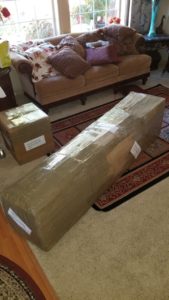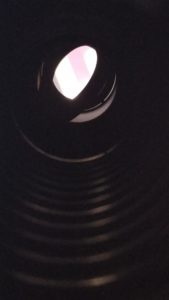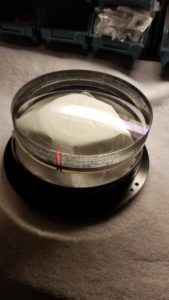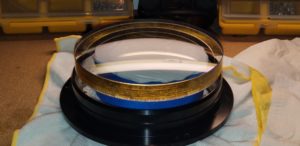Meade 178ed Lens cell Collimation / Centering/ Refurbishing and Baffle Reattachment
By: Vlad Fedosov
The Meade 178ED is quite a special scope to me. I have dreamed of owning one of these beasts since the late 1990’s when I was first getting into the hobby. Seeing the scope in the ad’s of Sky & Telescope would send chills down my spine. At the time being a high school student from a poor family the ~$7000 price tag that the scope had might as well have been $7 million… Fast forward about 20 years and I was finally ready to make the dream come true. I managed to snag the 178ED through a wanted ad on Cloudy Nights(after over a year of looking). A guy responded(who I thank dearly) saying that a camera shop in North Carolina has had one for years that they acquired from an estate. Seemed kind of a long shot, but I called them, and they did, in fact, have the 178ED just sitting in the backroom… They sent me some pictures, and the scope looked great! We agreed on a fair price on the scope/shipping, and it was just a matter of it surviving the cross-country trip vie UPS…

I’m sure you have read all the horror stories about the 178ED… Lol. When I bought the scope it did have two loose light baffles. The stock focuser was certainly not fitting of a 7” APO. At first, the optics looked fairly well aligned(even after it was shipped to me cross country) but then the lens centering did start to shift around… For the average guy, this would be a disaster of a scope just like you have read about(especially if you paid the $7k it cost back in the ‘90’s early 2000’s). With a little work, I have corrected all the issues. I re-glued all the baffles(easy), put a 2.5″ Moonlite focuser on it(easy), and took apart the lens cell to clean it all out and redo the tape shimming that these optics need to stay aligned(somewhat tedious and took a few attempts).

Now the scope is a total out of this world performer! Believe it or not, it actually has better color correction then the FS-128 that I had and the optics are about as sharp(Tak did have better contrast). I might have gotten lucky with my lens set being a really good one, but from what I gather of this scope the quality of the optics was not the issue, it was the poor execution of everything that went around them. A determined guy can get one of these and make this into by far the best bargain on a large APO out there!
Baffles:
After close inspection both my midsection and rear baffle were loose. I have no idea how you would know where to reattach them in the OTA if it were not for the marks in the matte black paint that’s inside the OTA. I searched the web on info on the glue that does not outgas and never found a good answer. I ended up using clear silicone. Worked like a charm! I also hit the inside of the OTA(where I could reach) with the ultra-flat black paint in the picture. I have used this stuff in the past and it works very well and is very matte. I did leave the OTA opened at the focuser end and had the optic removed for over a month just as a precaution to prevent the possibility of outgassing residue forming on the lens.
Optics:
The issue that I was having with my optics is that the centering would shift around when pointing around at different parts of the sky on a GEM mount. It’s interesting that the first few times that I used the scope this did not seem to be an issue but was quite apparent after I used the scope for a few months. My optics also needed a decent cleaning so I did not mind taking them apart.

The first thing that I would recommend is that you download the Meade ED Bible(ok its just a very good manual. Not mine and I take zero credit for having anything to do with writing it:). I won’t go into the details of what the manual already states, but will just add what I found to work after many attempts. I took my lens cell apart just like described in the manual by using a pedestal to get the elements out once the outer ring was unscrewed and the collimation screws were backed out. In my case, I did not have any tape around the lens elements as I believe someone had taken the lens apart in the past. There was immediately an issue found with this in that the orientation marks were way off. Easy fix as there is only one way they can match(my mark was about 1” across and you could not miss it. It was a red strip with black strips on either side). Link: Meade ED And Achromat Collimation 178ED Refractor (usermanual.wiki)

After giving my two lens elements a good bath I confirmed that they were in excellent shape with perfect coatings! My first attempt was to use black painters tape to try to keep the lenses orientation and to prevent them from excessively shifting around. Not knowing how much tape it would take to take up the slack I used two full circumference strips. This was way too much and the lens would not fit into the cell. I then tried one layer and even that was way too tick… In order to give it a shot I went down to only ½ of a circumference of the lens assembly and that did fit back into the lens cell. Well after trying to center the lenses I quickly found out that for one reason or another I could not get the centering of the lenses even close to what it needed to be. Back to the drawing board.
To make a long story short, what I ended up doing is ordering some electrical tape that was 1mil in thickness. This includes the adhesive layer. From what I understand this is the thinnest tape that money can buy. It’s still quite strong, and equally important does not leave any residue. Unfortunately, it’s not cheap and ran me about $60 including the shipping. I attempted several combinations of tape. In the end, what I found to work the best is that I started with cutting four 1” length pieces of the tape that where also cut down to the correct width of the two lens elements and metal spacer. I put them at every 45°’s of the lens assembly. This was easier to do than putting down a full circumference layer as the lenses would tend to shift around and it was just easier to preserve a perfect orientation doing this. I then followed up with a full circumference layer of tape that was again cut down to the correct width before applying.
After trying many different configurations the above configuration gave the most lens stability while still, not causing pinched optics or the lack of enough movement to get a proper centering. One note that I will make that I had an issue with by following the Meade ED manual is that I did need to tighten down the outer lens retaining ring about as tight as I could by hand. Essentially what keeps the bottom ED lens cell from shifting around is the centering ring/screws and what keeps the top lens element from shifting is that tightening ring.

In summary, if you happen to snag a good example of the Meade 178ED(of the smaller brothers) you are probably buying some good optics! There are a few shortcomings in the tube and lens cell design but nothing that a competent amateur astronomer cant fix relatively easily. If you are buying one of these that is not documented as being gone through you should look at this as a fun project to do over several months. If you buy one of these and expect to have a 100% turn-key scope you will likely be disappointed. Why would you even want to bother then? Well, what other 7” APO can the average guy afford? LOL.

